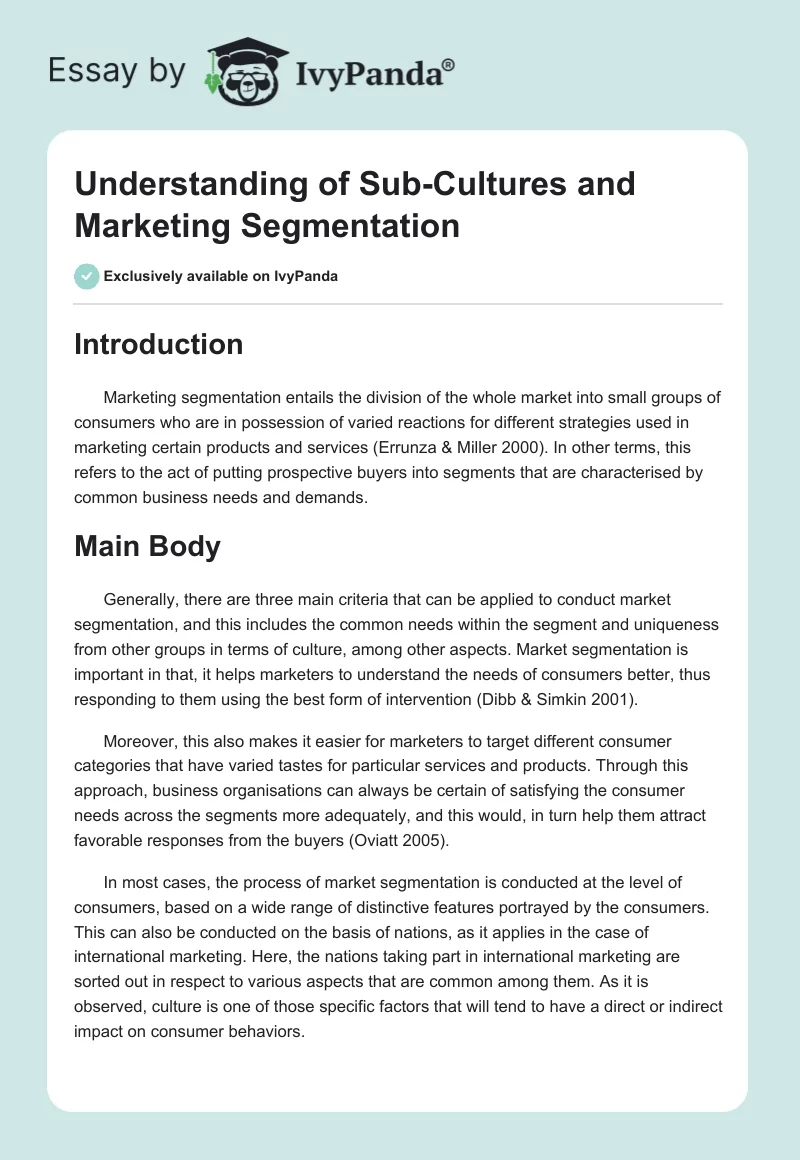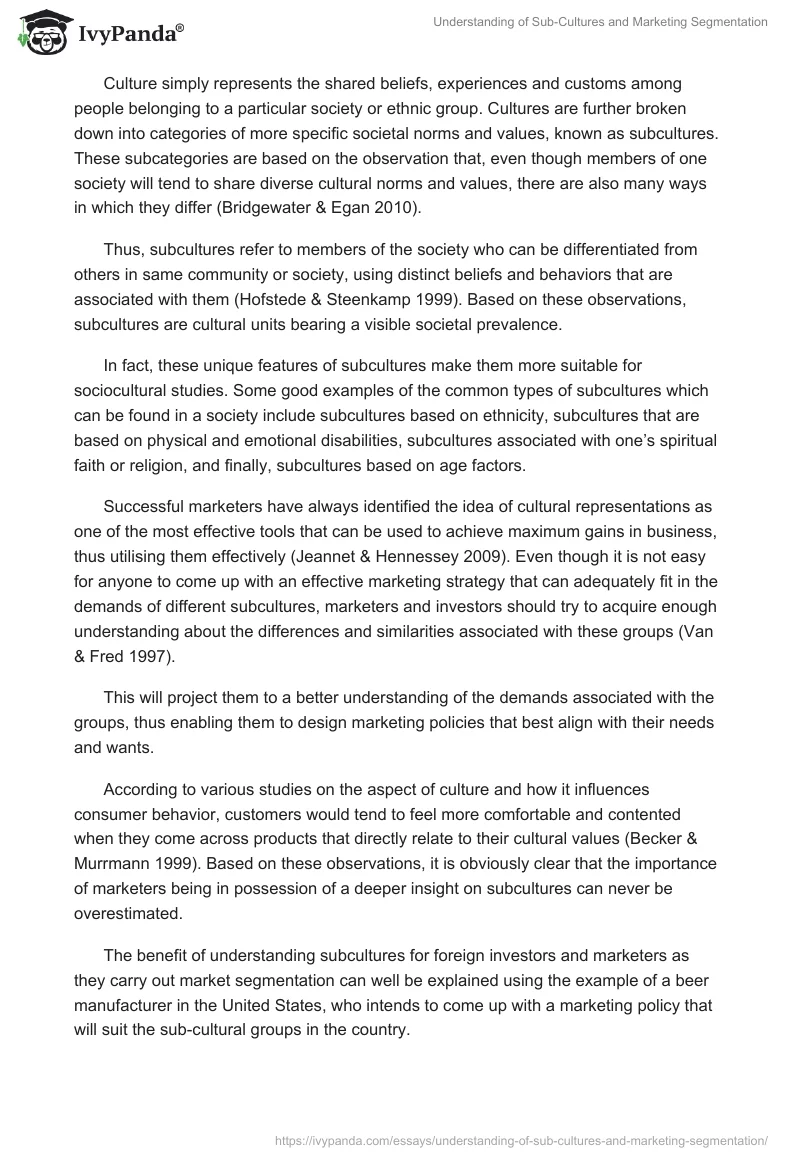Introduction
Marketing segmentation entails the division of the whole market into small groups of consumers who are in possession of varied reactions for different strategies used in marketing certain products and services (Errunza & Miller 2000). In other terms, this refers to the act of putting prospective buyers into segments that are characterised by common business needs and demands.
Main Body
Generally, there are three main criteria that can be applied to conduct market segmentation, and this includes the common needs within the segment and uniqueness from other groups in terms of culture, among other aspects. Market segmentation is important in that, it helps marketers to understand the needs of consumers better, thus responding to them using the best form of intervention (Dibb & Simkin 2001).
Moreover, this also makes it easier for marketers to target different consumer categories that have varied tastes for particular services and products. Through this approach, business organisations can always be certain of satisfying the consumer needs across the segments more adequately, and this would, in turn help them attract favorable responses from the buyers (Oviatt 2005).
In most cases, the process of market segmentation is conducted at the level of consumers, based on a wide range of distinctive features portrayed by the consumers. This can also be conducted on the basis of nations, as it applies in the case of international marketing. Here, the nations taking part in international marketing are sorted out in respect to various aspects that are common among them. As it is observed, culture is one of those specific factors that will tend to have a direct or indirect impact on consumer behaviors.
Culture simply represents the shared beliefs, experiences and customs among people belonging to a particular society or ethnic group. Cultures are further broken down into categories of more specific societal norms and values, known as subcultures. These subcategories are based on the observation that, even though members of one society will tend to share diverse cultural norms and values, there are also many ways in which they differ (Bridgewater & Egan 2010).
Thus, subcultures refer to members of the society who can be differentiated from others in same community or society, using distinct beliefs and behaviors that are associated with them (Hofstede & Steenkamp 1999). Based on these observations, subcultures are cultural units bearing a visible societal prevalence.
In fact, these unique features of subcultures make them more suitable for sociocultural studies. Some good examples of the common types of subcultures which can be found in a society include subcultures based on ethnicity, subcultures that are based on physical and emotional disabilities, subcultures associated with one’s spiritual faith or religion, and finally, subcultures based on age factors.
Successful marketers have always identified the idea of cultural representations as one of the most effective tools that can be used to achieve maximum gains in business, thus utilising them effectively (Jeannet & Hennessey 2009). Even though it is not easy for anyone to come up with an effective marketing strategy that can adequately fit in the demands of different subcultures, marketers and investors should try to acquire enough understanding about the differences and similarities associated with these groups (Van & Fred 1997).
This will project them to a better understanding of the demands associated with the groups, thus enabling them to design marketing policies that best align with their needs and wants.
According to various studies on the aspect of culture and how it influences consumer behavior, customers would tend to feel more comfortable and contented when they come across products that directly relate to their cultural values (Becker & Murrmann 1999). Based on these observations, it is obviously clear that the importance of marketers being in possession of a deeper insight on subcultures can never be overestimated.
The benefit of understanding subcultures for foreign investors and marketers as they carry out market segmentation can well be explained using the example of a beer manufacturer in the United States, who intends to come up with a marketing policy that will suit the sub-cultural groups in the country.
In this case, the entire American market is said to be categorised into three sub-cultural classes which include African Americans, Asians and Hispanics. Of concern is here the fact that, these sub cultural groups share a common factor of being minorities in the country. More importantly, each of these subcultures has over the years played a key role in the U.S. politics and culture, thus acquiring much recognition from the entire American society.
However, apart from the common cultural norms and values shared by the three sub-cultural groups, they differ greatly in terms of language, beliefs, and eating habits. More importantly, these groups also differ largely in terms of diversity and social status, among other prevailing aspects. In this respect, it would be necessary for the beer manufacturer to have a better knowledge of the three sub-cultural groups, before unveiling the exercise of designing the most relevant marketing strategies that will apply.
Conclusion
As it is shown in this paper, international marketers and investors should be able to use effective marketing strategies to win the admiration of every consumer within this particular setting. As it has been portrayed here, using the diverse opportunities provided by subcultures to conduct market segmentation is certain to place international marketers on a stronger basis when it comes to global marketing.
This gives them a thorough understanding of the consumer needs and demands across different regions, thus applying the most appropriate intervention to address them. Having a sound knowledge of sub cultural units is indeed a crucial marketing tool that should be embraced by any marketer who aspires to make a difference in the international marketing.
References
Becker, C & Murrmann, S 1999, ‘The effect of cultural orientation on the service timing preferences of customers in casual dining operations: an exploratory study’, International Journal of Hospitality Management, vol. 18, no. 1, pp. 59-65.
Bridgewater, S & Egan, C 2010, International Marketing Relationships, Palgrave Macmillan, Hampshire.
Dibb, S & Simkin, L 2001, ‘Market segmentation: diagnosing and treating the barriers’, Industrial Marketing Management, vol. 30, no. 8, pp. 609-625.
Errunza, V & Miller, D 2000, ‘Market segmentation and the cost of the capital in international equity markets’, Journal of Financial and Quantitative analysis, vol. 35, no. 4, pp. 577-600.
Hofstede, F & Steenkamp, J 1999, ‘International market segmentation based on consumer-product relations’, Journal of Marketing Research, vol. 12, no. 6, pp. 1-17.
Jeannet, J & Hennessey, H 2009, Global Marketing Strategies, Houghton Mifflin, Boston, USA.
Oviatt, B 2005, ‘Defining international entrepreneurship and modeling the speed of internationalization’, Entreprenurship Theory and Practice, vol. 29, no. 5, pp. 537-554.
Van, R & Fred, W 1997, ‘Globalisation of marketing communication’, Journal of Economic Psychology, vol. 18, no. 2, pp. 259-270.


